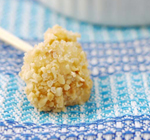
the art of packaging
My daughter likes to eat muah chee. Last week, I discovered one of my favourite lunch spots sold excellent muah chee in quantities of two, neatly presented in a ...
More
image . en.wikipedia.org .
text . Pauline Chan .
When I moved to Brunei years ago, I was introduced to stir-fried vegetables that my mother-in-law picked from the overgrown vegetation outside her fence. I couldn't turn down the offer of a specially cooked plate of weeds harvested from the edge of the unkempt grassland that notoriously hid monitor lizards and snakes without seeming rude and haughty. So, I took some with my rice and from that very moment onwards, never looked down on weeds plucked from no-man's land again.
Brunei, Sabah and Sarawak have in their markets some weedy 'backyard' vegetables that make the most tasty dishes. Some highly-popular ones grow wild and in abundance without any maintenance such as forest ferns like Lemidin and Pucuk Paku. Rural dwellers have always used ferns in their diet as they are considered tasty and nutritious vegetables. This jungle fern’s rise from rural staple to urban gourmet probably occurred in the 1980s with the increased urban migration of local tribes.
Over the years, I have often served up these 'backyard' vegetables and have grown rather fond of other farmed green specialties that I only got to savour when I set foot on this island, many years ago.
1. Lemidin - Known by a number of names, Midin, Bilin or Milin, this fern (stenochlaena palustris) has curly fronds and is usually harvested when the leaves are young with a brownish red colour. Midin grows extremely fast. In just two to three days the young fronds are ready to be picked. If they are not harvested within a few days, the tender young shoots become tough and are no longer desirable. Typically stir-fried hot and spicy style with sambal belachan - a mixture of belachan (shrimp paste), crushed dried shrimps, chili and shallots. 
2. Pucuk Paku - Also known elsewhere in the world as Fiddlehead ferns. Fiddleheads have been part of traditional diets in much of Northern France since the beginning of the Middle Ages, Asia as well as among Native Americans for centuries, so this is not peculiar to Borneo. Here in Borneo, the ferns are usually done hot and spicy, much like the Lemidin, and not over-cooking them to retain a crunchy texture.
3. Kacang Botol - Winged beans or four-angled beans (psophocarpus tetragonolobus), are shiny, frilly-edged crunchy legumes that grow on a vine. They taste somewhat like asparagus and has been called the 'one-species supermarket' because practically every part of the plant can be eaten. It seems the leaves, flowers and tuberous roots are also edible though I have not seen them marketed here. Besides the usual popular stir-frying technique, again with the famed sambal belachan, (here in Borneo, anything can be great with sambal belachan), the winged beans can be lovely taken raw as a salad with some lime juice and julienne shallots.
4. Cangkuk Manis - Sauropus androgynus - a dark green-leaf plant that grows very easily. Only the leaves are eaten so the leafless stalk can be pushed into the soil and they will sprout leaves and multiply without any help. The leaves are plucked from the stems and torn or crushed before cooking. A popular style is to fry the crushed leaves with eggs. Another is to add them to boiling stock and eaten with steamed rice.
5. Curly Snake Bean - Visually different from the common Chinese long bean or yardlong bean, this variety is curly, with a rougher and thicker skin. Lightly cooked, these beans produce a sweeter taste and crunchier feel. They cost more than the common long beans and will definitely not win any good-looking-vegetable prize, but personally, they are preferred in my household where longish vegetables are concerned.

the art of packaging
My daughter likes to eat muah chee. Last week, I discovered one of my favourite lunch spots sold excellent muah chee in quantities of two, neatly presented in a ...
More

amali's quaint and quiet corner
Whenever I am out and about town on my own, I am wont to walk into a quiet eatery and just dine on my own, and while away the minutes with a magazine or paper. ...
More

pasta la vista!
The Italians own the pasta that we are all familiar with now and how lucky they are for it is such a wonderfully versatile ingredient that appeals to ages from 1 ...
More